January 07, 2015
By Brad Miller, Ph.D.
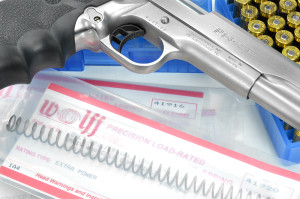 Recoil spring rate must be balanced with the ammunition in order to keep the gun running reliably and to prevent excess wear from battering. Spring rate affects timing during the recoil and feeding cycle. If the recoil spring is too strong, the gun won't cycle reliably and can cause failures in extraction and ejection, and feeding malfunctions by not going far enough to the rear or by cycling so fast that the round in the magazine hasn't been pushed up far enough for proper engagement.
Recoil spring rate must be balanced with the ammunition in order to keep the gun running reliably and to prevent excess wear from battering. Spring rate affects timing during the recoil and feeding cycle. If the recoil spring is too strong, the gun won't cycle reliably and can cause failures in extraction and ejection, and feeding malfunctions by not going far enough to the rear or by cycling so fast that the round in the magazine hasn't been pushed up far enough for proper engagement.
The effect of recoil spring strength on timing was examined with three different recoil springs in a .45 ACP Para Ordnance P14.45 (5" barrel) pistol. The springs were Wolff 12-, 16- and 20-pound (lb) conventional springs. The 16 lb recoil spring is the standard weight for this pistol.
Methods
The springs were conditioned to take a "set" prior to use. "Set" refers to new springs shortening a little with their initial use. This was done to reduce variability in the spring's response due to shortening that might occur during the time course of the test.
Advertisement
They were installed and removed 60 minutes later and measured. The springs shorted 1 millimeter (mm) (see the Table).
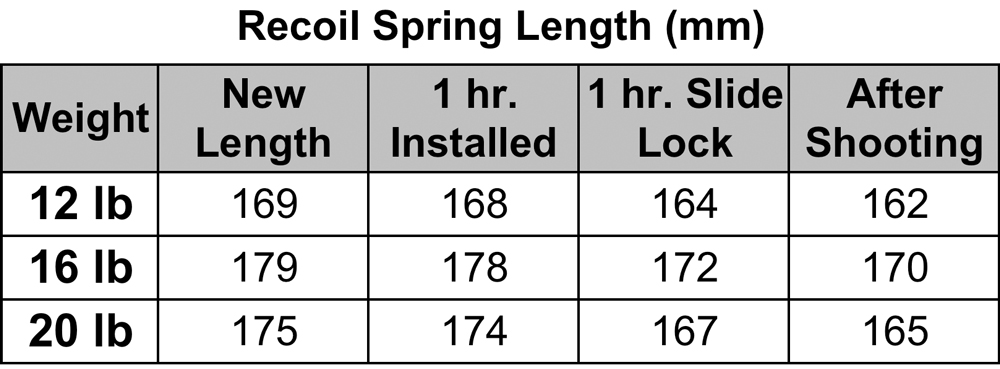 They were reinstalled and the slide was locked to the rear for 1 hour. This reduced their length 4 to 7 mms. They were not installed again until immediately prior to use at the range. After the spring was installed, the different types of ammunition were fired in the same order in case firing live ammo produced additional set that could affect spring behavior. They were measured again after shooting and each spring had shortened an additional 2 mms.
They were reinstalled and the slide was locked to the rear for 1 hour. This reduced their length 4 to 7 mms. They were not installed again until immediately prior to use at the range. After the spring was installed, the different types of ammunition were fired in the same order in case firing live ammo produced additional set that could affect spring behavior. They were measured again after shooting and each spring had shortened an additional 2 mms.
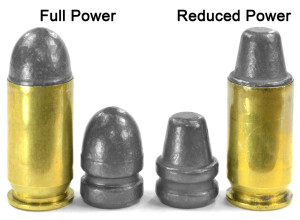 Two different loads were tested. A full power load was 230-grain Bear Creek Supply moly coated RN bullets loaded with 5.8 grains of Winchester 231 to 1.250" overall length in Speer brass that averaged 842 feet-per-second (fps). Calculations show that it would produce 5.97 foot pounds of recoil force in a 2.5-pound gun. A reduced power load was 185-grain Bear Creek Supply moly coated SWC bullets loaded with 5.0 grains of 231 to 1.240" overall length in Remington brass that averaged 797 fps producing 4.08 foot pounds of recoil.
Two different loads were tested. A full power load was 230-grain Bear Creek Supply moly coated RN bullets loaded with 5.8 grains of Winchester 231 to 1.250" overall length in Speer brass that averaged 842 feet-per-second (fps). Calculations show that it would produce 5.97 foot pounds of recoil force in a 2.5-pound gun. A reduced power load was 185-grain Bear Creek Supply moly coated SWC bullets loaded with 5.0 grains of 231 to 1.240" overall length in Remington brass that averaged 797 fps producing 4.08 foot pounds of recoil.
Advertisement
The gun was held in a Ransom Rest and a close-up of the slide was recorded with a high speed (1000 frames per second (FrPS)) digital camera during firing. Ten rounds were fired with each type of ammo (two) with each spring (three) for a total of 60 rounds video recorded (10 X 2 X 3 = 60). Only six to seven rounds were loaded in the magazine at a time. This was done to reduce the amount of nosedive that rounds might have due to the presence of a nosedive gap that can appear between the top round and the underlying round as more rounds are loaded in the magazine. Prior tests in a single column 1911 have shown that the greater the nosedive a cartridge makes during feeding, the slower the total cycle time. However there is less nosedive gap in these double column magazines with six to seven rounds loaded and there was no discernible effect from this phenomenon in this data.
The video was analyzed for three key milestones in the firing cycle. 1) Recoil time: the time it took for the slide to move all the way to the rear under recoil. 2) Cartridge pick-up: when the slide first contacted the top round in the magazine as it moved forward. 3) Total cycle time: when the slide returned fully to battery.
Results
Cycle time was fast - much less than a tenth of a second. In fact, the slowest cycle time was 59 frames, or 59 milliseconds (59 ms; 0.059 seconds), and that was with the 12 lb spring. The slowest cycle time with the 16 lb spring was 50 ms. That's 1/20 of a second. The slowest time with the 20 lb spring was 47 ms.
The general result is just what one would expect: recoil spring weight affects the speed of the slide in the recoil and return phases of the firing cycle. For example, a weaker spring has a faster recoil time but a slower total cycle time. The reverse is true with a stronger recoil spring. A close look at the milestone events revealed interesting consequences from spring rate for timing in the firing cycle.
The general time profiles of the measured milestones for both types of ammunition are shown in the figure. Two things are apparent. First, the different spring weights produced different times at most milestones, although the recoil phase was very similar for all springs. Second, the overall profiles are similar for both types of ammunition. In fact, the total cycle time for a given spring with both the full power and reduced power ammunition was virtually the same.
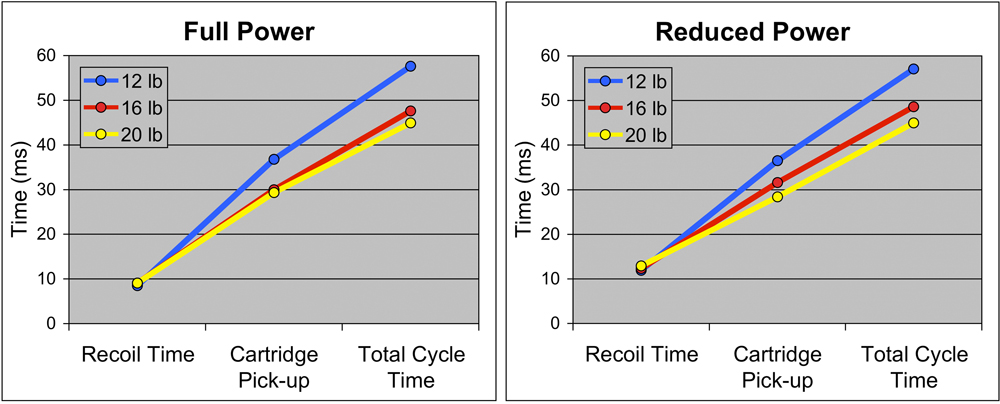 A spring's behavior was very consistent within a given 10-shot string. Almost half (8 of 18) of the 10-shot string milestones had an extreme spread in time of only 1 ms. For example, cartridge pick-up time for all 10 shots with the 16 lb spring and the 185 grain bullet ranged from only 31-32 ms. The largest extreme spread time for any 10-shot group was 4 ms.
A spring's behavior was very consistent within a given 10-shot string. Almost half (8 of 18) of the 10-shot string milestones had an extreme spread in time of only 1 ms. For example, cartridge pick-up time for all 10 shots with the 16 lb spring and the 185 grain bullet ranged from only 31-32 ms. The largest extreme spread time for any 10-shot group was 4 ms.
 An example of the consistency is shown in the figure, which shows the time profiles of all ten shots with the 16 lb spring and the 185-grain bullet. The lines and dots overlap and are difficult to distinguish from one another because the times are so consistent.
An example of the consistency is shown in the figure, which shows the time profiles of all ten shots with the 16 lb spring and the 185-grain bullet. The lines and dots overlap and are difficult to distinguish from one another because the times are so consistent.
Recoil Time
We generally accept that there is a significant difference in how fast the slide moves rearward from recoil with different weights of recoil spring. Changing recoil springs usually results in the brass being ejected a greater or lesser distance. I expected to see a clear difference in slide recoil time with the different springs. However, the difference was small, at best.
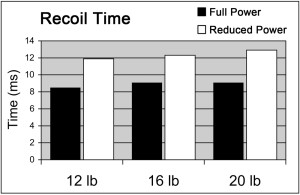 With full power ammunition, recoil time averaged 9.1 ms with both the 16 and 20 lb springs. The 12 lb spring was a little faster with an average time of 8.5 ms. The difference in recoil time with the reduced power ammunition was a little more apparent, with the 12, 16 and 20 lb springs averaging 11.9, 12.3 and 12.9 ms, respectively. A one millisecond difference between the 12 and 20 lb springs is not much actual time, but does represent a 8% difference.
With full power ammunition, recoil time averaged 9.1 ms with both the 16 and 20 lb springs. The 12 lb spring was a little faster with an average time of 8.5 ms. The difference in recoil time with the reduced power ammunition was a little more apparent, with the 12, 16 and 20 lb springs averaging 11.9, 12.3 and 12.9 ms, respectively. A one millisecond difference between the 12 and 20 lb springs is not much actual time, but does represent a 8% difference.
The numbers also show that the springs readily distinguished between the two loads used in this test. The recoil time for the reduced power load with the 12, 16 and 20 lb springs was 40%, 35% and 42% longer, respectively, than the full power load. The reduced power load produced 32% less recoil force than the full power load, so the springs are quite sensitive to differences in recoil.
My impression while analyzing the video was that the camera frame rate (1,000 FrPS) was probably not fast enough to give the best account of recoil time differences. A faster frame rate would provide a clearer picture of rearward slide travel. In spite of this shortcoming, it was clear that the recoil phase was not dramatically different between these spring weights when using the same ammunition. The slide moved much slower when going forward and the video frame rate was more than adequate during that phase.
Cartridge Pick-up
 With full power ammunition, the slide was significantly slower to pick-up the cartridge with the 12 lb spring (36.8 ms) than with the 16 and 20 lb springs, which were nearly the same time (30 and 29.3 ms, respectively). The difference between the three springs in pick-up time with the reduced power ammunition was more apparent, with the 12, 16 and 20 lb springs averaging 36.5, 31.6 and 28.4 ms, respectively.
With full power ammunition, the slide was significantly slower to pick-up the cartridge with the 12 lb spring (36.8 ms) than with the 16 and 20 lb springs, which were nearly the same time (30 and 29.3 ms, respectively). The difference between the three springs in pick-up time with the reduced power ammunition was more apparent, with the 12, 16 and 20 lb springs averaging 36.5, 31.6 and 28.4 ms, respectively.
A spring's cartridge pick-up time was very similar with both the full power and reduced powered ammunition. The 16 lb spring was 1.6 ms slower with the reduced powered load, but the 12 and 20 lb springs were a fraction of a second faster.
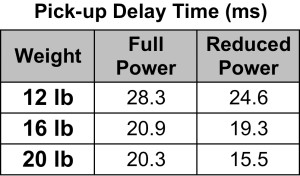 The difference between the spring weights can be viewed in terms of the pick-up delay time, which is the time between when the slide stops moving rearward until it picks up the next round. This is an important feature in the timing of the firing cycle. The delay is longest with the weakest spring (see the table) because the slide moves to the rear faster but it moves forward slower. With weaker ammunition, this delay is reduced because of the slower recoil phase.
The difference between the spring weights can be viewed in terms of the pick-up delay time, which is the time between when the slide stops moving rearward until it picks up the next round. This is an important feature in the timing of the firing cycle. The delay is longest with the weakest spring (see the table) because the slide moves to the rear faster but it moves forward slower. With weaker ammunition, this delay is reduced because of the slower recoil phase.
A certain amount of time is required for the top round in the magazine to be pushed up to the top of the magazine after the slide has moved far enough to the rear to allow the cartridge to move. Factors that affect this aspect of timing are the strength of the magazine springs, the number/weight of rounds in the magazine and, as shown here, the strength of the recoil spring. In the Government Model 1911, the slide clears the magazine after roughly 75% of its rearward travel, allowing the ammunition to move up. This critical part of timing is rarely a problem since there is usually more than sufficient time for the top round to be positioned for pick-up before the slide contacts it during forward travel.
The slide can cycle too fast and outrun the magazine spring in certain conditions. For example, Clark Custom Guns does not recommend the use of a .460 Rowland on a high capacity Para Ordnance P14.45 for this reason (as per email communication on 12-8-2014). A full magazine (14 rounds) of .460 Rowland ammunition (essentially the same as .45 ACP) is heavy, which can slow the push of the rounds upward. The strong recoil spring recommended for the .460 Rowland means that it returns the slide quickly after recoil. This has sometimes led to feeding malfunctions because there wasn't always enough time for the top round to be where it should in time for proper pick-up.
Total Cycle Time
The relative speed differences between the three spring weights is more pronounced when looking at the total cycle time. Stronger springs return the slide to battery at a significantly faster speed. The average total cycle time was 57 ms for the 12 lb spring, 48 ms for the 16 lb spring and 45 ms for the 20 lb spring. The total cycle times for the individual springs were extremely consistent within the 10-shot strings, and the extreme spreads did not exceed two milliseconds.
The total cycle times for the full power and reduced power ammunition was nearly identical and did not differ more than one ms for a given spring. This suggests that while recoil springs are sensitive to differences in the power level of the ammunition tested here during the recoil phase, it makes little difference in the overall cycle time.

Not Just Timing
Recoil spring strength also affects how the gun's sights realign on the target when making fast followup shots. Some shooters report that a strong recoil spring makes the nose of the gun dip downward more than a light spring when the slide returns to battery. This makes sense because it returns the slide to battery faster. Some competitive shooters often spend time testing different recoil spring weights to see which will fit their shooting technique best.
Summary
A weaker recoil spring has less resistance to recoil force and allows the slide to recoil faster. It also has less force to push the slide forward to return to battery resulting in a slower total cycle time. It's just the opposite for a stronger recoil spring.
The recoil force of the ammunition affected the recoil time, but did not affect the total cycle time.
Spring strength affects the firing cycle timing, and one of the most important events is cartridge pick-up time. Slide timing must permit the next round in the magazine to be pushed up in time so that it is in the right position to be engaged by the slide for feeding.
Generally, there is wide latitude for the ammunition that will reliably operate with a given recoil spring. For example, nearly all factory ammunition will run reliably with "standard" weight recoil springs in most pistols. Also, all of the ammunition in this test cycled reliably with no malfunctions of any kind. Even the reduced power load functioned reliably with the strong 20 lb spring.
Sometimes there are good reasons to change recoil springs, for light or heavy loads or to change how the nose of the gun dips for quicker follow-up shots. In these instances, it's good to know how different spring weights can affect firing cycle timing.
Shooting Times Ammo Reports
Pistol Powerhouse: The 9x23 Winchester
What's the Best Cartridge for Coyote Hunting?
Most fast varmint-type cartridges work just fine, but there are a few that excel. What cartridge would you choose for a dedicated predator-hunting cartridge?
Read the full article here.How to Reload 7.62x54R for Mosin Nagants
Handloading the 6.5mm Grendel
Sometimes you find a cartridge that really shines when it's handloaded, and it reinforces the notion that reloaders can improve the performance of their chosen cartridge and firearm. The 6.5mm Grendel is just such a cartridge.
Learn how to handload the 6.5mm Grendel.Essential Reloading Tools
Reloading tools are a lot like kitchen appliances; there are a lot that make life easier, but only a few that are absolutely necessary.
Find the best reloading tools.
